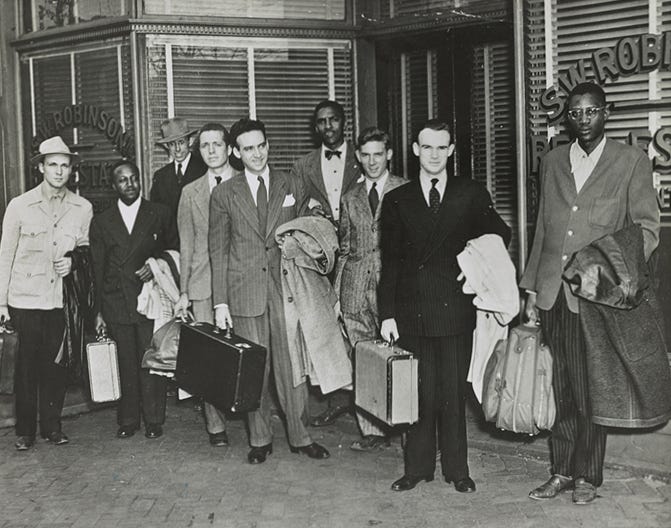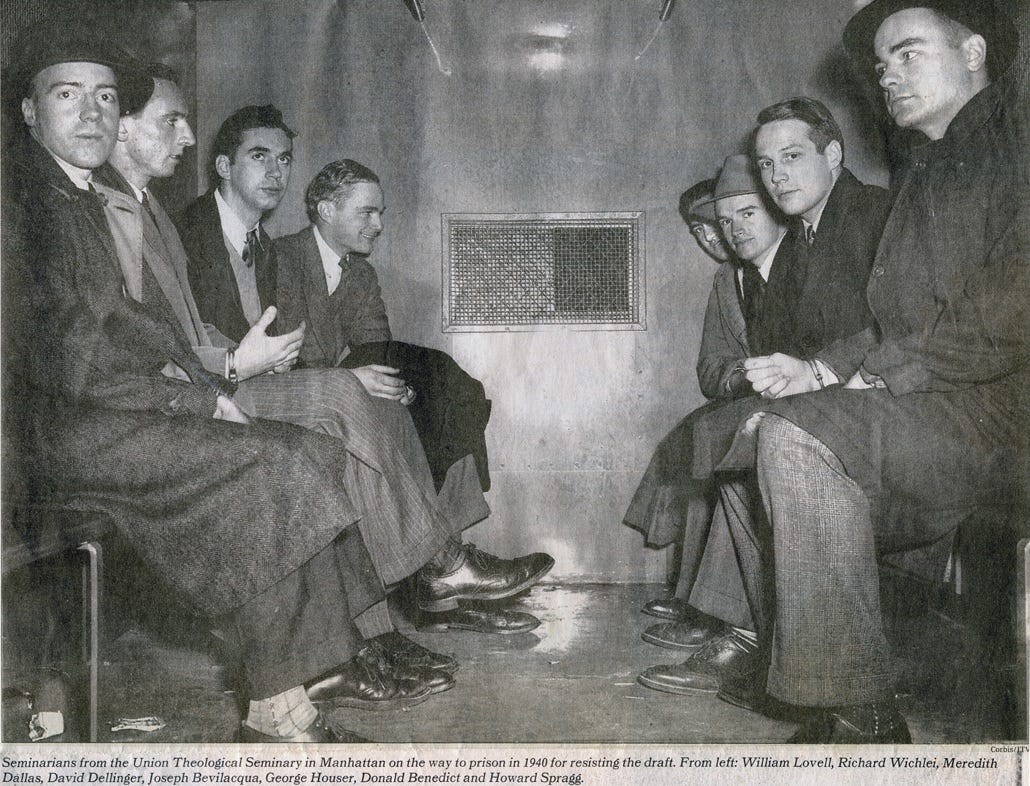George Houser and the Union Eight
They were jailed for resisting the draft, even though they were exempt from serving.
The son of Methodist missionaries, George Houser was a pacifist with a strong sense of social justice. After finishing his undergraduate degree, Houser decided to study for the ministry. He moved to Manhattan and entered Union Theological Seminary in 1938. While there, he joined the Seminary’s Social Action Committee, eventually becoming its chairman. He also participated in his first picket line (with the Brotherhood of Sleeping Car Porters) and joined the Fellowship of Reconciliation (FOR), a pacifist organization.
As war raged in Europe, President Roosevelt signed the Selective Training and Service Act into law on September 16, 1940. It was the first peacetime draft in US history. All men between the ages of 20 and 45 were required to register for the draft. Some who registered would not be called up because they were employed in one of 34 occupations of “national importance” (in war production or agriculture, for example), because they had dependents, or because of their physical or mental health.
Dismayed by the public support for the Selective Service Act, Houser wrote in his diary, “It seems to me that the only thing that might awaken people to their prejudices is for someone to refuse to comply with the Act. It might cause them to consider what the real nature of conscription is, and whether our democracy can be defended by force of arms.”
Other students at Union Theological Seminary agreed.
Late in the night of October 19, 1940, Houser and his roommate, Howard Spragg, were awakened by two Union students who were composing a statement to announce that they were going to refuse to register for the draft. Houser and Spragg worked along with David Dellinger, Donald Benedict, and Meredith Dallas to write the statement.
But here’s the thing. None of these students were in any danger of being drafted. In addition to the above occupations of national importance, clergy and divinity students were exempt from the draft.
They could also be exempted as conscientious objectors, who "by reason of religious training or belief, [are] conscientiously opposed to the participation of war in any form."
The students rejected the exemptions for their status as seminary students or for conscientious objection. They viewed such exemptions as political, since “without such a provision, public opposition to war would be too great to handle. In particular, it seems to us that one of the reasons the government has granted exemptions to ministers and theological students is to gain a religious sanction for its diabolical war.”
But they were still required to register, even with exemptions protecting them from being drafted. Houser later recalled, “It was still peacetime, this was a year and some months before Pearl Harbor. The possibility of war was there, but this was a peacetime conscription act and the only way, or the most effective way many of us figured, of protesting against it, was to refuse to register under the law.”
Twenty students signed the statement, declaring that they would “refuse to cooperate with the government in any way in regard to the Selective Training and Service Act of 1940.” The group sent copies of the statement to friends, pacifist groups, theological schools, and 1,500 ministers.
And to the press.
The story made nationwide newspaper headlines, and was featured on the radio and in newsreels. Letters to the editor and editorials condemned the students as un-American.
Colonel Arthur McDermott, director of the Selective Service in New York called the students “so-called young intellectuals who have smugly decided that their judgement and intelligence is so far superior to that of Congress and the American people that they propose to disdain the requirements of the law.” He threatened them with the prospect of five years in prison and a $10,000 fine.
There was pressure from Union Theological Seminary, as well. Hundreds of letters and telegrams to the school criticized the students. Angry calls from donors demanded the students be expelled. The school’s president, Henry Sloane Coffin, feared the loss of funding, but refused to expel the students. Instead, he sent telegrams to the students’ families, urging them to convince their sons to back down. Houser’s parents supported his decision, with some trepidation.
By registration day, October 16, 1940, twelve of the twenty students decided to register as conscientious objectors. The eight who remained met in silent prayer, then walked together to the room where students were registering. They handed a copy of their statement to the draft board and were served with subpoenas.
The next day, the Union Eight appeared before a grand jury and were indicted. The trial was set for November 14. The students were offered multiple occasions to change their minds, both in the weeks leading up to the trial and during the trial itself.
The students held firm in their convictions.
The judge sentenced them to a year and a day in federal prison, but offered to shorten their sentences if they changed their minds and registered. They did not change their minds. The men were fingerprinted, handcuffed, and photographed. After a week in a Federal Detention Center in New York, they were transferred to a Federal prison in Danbury, Connecticut.
On September 3, 1941, Houser and the other seven inmates were released—72 days early—because of “good behavior.” They met individually with the warden, who handed each of them a draft card to sign. They all refused.
Henry Sloane Coffin offered to readmit the men to Union Theological Seminary—with conditions. They must concentrate only on their studies and do nothing that would bring more bad publicity to the school. The conditions were unacceptable to all eight men. Three left school altogether to continue social justice work. Five men, including Houser, continued their studies at the Chicago Theological Seminary, where their pacifism was welcomed.
Houser completed his studies and was ordained as a Methodist minister. Instead of accepting an assignment to a church, he joined the struggle against Jim Crow segregation in the United States.
In 1942, Houser was one of the founding members of the Congress of Racial Equality (CORE). In the early days of CORE, Houser and others adapted and refined Gandhi’s methods of nonviolent direct action to desegregate restaurants, theaters, roller rinks, swimming pools and barber shops. Houser recounts these early efforts in the 1945 publication, Erasing the Color Line. In 1947, Houser and Bayard Rustin organized the Journey of Reconciliation, an interracial effort to bring attention to the Supreme Court decision that made segregation in interstate transportation unconstitutional.

Later in his life, Houser turned most of his attention to Africa. He established the American Committee on Africa in 1953 and the Africa Fund in 1966. He spent decades working with African countries for independence from European colonization, and in South Africa against apartheid.
George Houser’s life was spent seeking justice, not for himself, but wherever he saw injustice.
While he was in no danger of being drafted, he refused to register because he felt that conscription and war were wrong.
While he was not forced to sit in the back of a bus, he co-founded CORE because he felt that segregation and racial discrimination were wrong.
While he did not live in Africa, he founded the American Committee on Africa and the African Fund because he felt that colonialism and apartheid were wrong.
Houser reflected on his life of activism. “I had the great sense of being involved in something great that happened in human history,” he said. “I don’t say that I contributed a lot to it, but I touched it. And it touched me.”
Houser died in 2015, at age 99. In an obituary, Peter Cole wrote, “For more than seventy years, Houser fought for racial equality in the United States, the independence of dozens of African nations, and peace. He did not seek the limelight. He did not expect change to happen overnight. He did not stop fighting.”
Sources and resources:
Ubuntu: George M. Houser and the Struggle for Peace and Freedom on Two Continents by Sheila D. Collins.
No One Can Stop the Rain: Glimpses of Africa’s Liberation Struggle by George M. Houser
Direct Action: Radical Pacifism from the Union Eight to the Chicago Seven by James Tray








